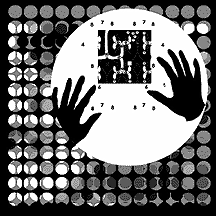"With desktop publishing making typesetting electronic and functionally opaque, and as clean and easy as typing, women (as former typists) are filling the ranks. Are the skills once valued in male typographers equally valued in female typesetters? It may be significant that the professional title of “typographer” is no longer used and the general activity less respected because “anyone (read women) can do it.” {37}
Martha Scotford
Messy History vs. Neat History: Toward an Expanded View of Women in Graphic Design
6. Separate
Computer typesetters peck and scratch, sorting their feed,distinguishing grain from dirt, picking through the dark tidbits to make a word. The graphic design production worker must sort files, search for typos, and separate data. She will perform tedious operations on image resolution, optimizie files, spec type. The work can be boring and niggling. Discerning this type face from that. This CMYK color from that RGB one. Granted, Vannever Bush wrote As We May Think in 1945, but it is interesting to note that the only instance in his prophetic document where the pronoun goes feminine is when he refers to a typist. The physician, the mathematician...are male. But the disembodied hands of the tedious data entry worker...is a she. The work of the hands, handiwork, is so often relegated to the female. From berry picking to needle point to data coding...women throughout time have been praised for their hand-eye coordination, their attention to detail. Will this continue to be the place we find women in the web’s working world?
High Tech High Touch, a pop culture book with a nose for trends, identified an increase in consumer desire for tactile products as a reaction to the 1990’s barrage of slick high tech gadgets. Consumer research has spawned a new wave of colorful tech toys, blueberry imacs and iridescent palm pilots among others. Computer products boast new levels of customizability, giving consumers the illusion at least that their pricey electronics are special. Indeed, these high tech objects are beloved by their twenty-first century possessors. Some seem obsessively attached to their cell phones and personal computers, transitional objects which create an intermediate space for work and play and human connection. It’s not difficult to imagine curling up with a tactile electronic device to read a new wave of fairy tales. My fantasy ebook has a velvet cover, embroidered with decorative motifs that pay homage to the tale’s history in both oral and storybook form. When my eyes grow weary, I push an imaginary button which activates the ebook’s voice. I shut my eyes and the book reads me to sleep...
Digital storytelling can provide a media-rich mix of color, image, sound and text. On the web, this potential is placed in the hands of any folk who have access to the technology, momentarily displaced from the hands of larger publishing conglomerates. I see the web, the design of personal websites, as the folk art of this era. Personal homepages spring up over night, decorative and intricate storytelling spaces. Folk artists voluntarily bent on these obsessive creations, are offering up their strange visions as gifts to their own cyber-communities. They craft designs to contain their stories which are passed via the new utopia of the web.
Digital representation re-imagines the morality and emotions of social interaction and mathematizes our experience of the physical world. In electronic media, human expression of selfhood, group-dom, and nationhood take up older media forms to articulate a sense of the contemporary scene. Hyper-text markup language (HTML), from this angle, is a new needlepoint.o38
Michael Dartnell
HTML As Needlepoint

Graphic design, a profession historically linked to craftwork, is one high-tech career choice luring the creative worker. The tantalizing promise: She may apply her artistic talents...and make money too! But many of the positions are production jobs, the laborious execution of someone else’s vision: optimizing images and tweaking files, the digital copy-and-paste of design. Perhaps the spinning and weaving of today takes the form of graphic design. The html coder, the graphic designer, logs in long hours at the computer’s loom. She may very well work with an ear to talk radio, absorbing stories to the rhythm of her craft. If storytelling developed as an art concurrent with the tasks of thread work...the knotting and net mending of a fisherman, the weaving and lace making of his wife, do these audio/visual patterns influence each other, merging and repeating rhythmically in each new narrative form?
YOU'VE GOT MAIL!
Subject: "cinderella boy"
Date: Thu, 5 Apr 2001 15:34:37 -0500
From: "Rob Wittig"
"For storytelling is always the art of repeating stories, and this art is lost when the stories are no longer retained. It is lost because there is no more weaving and spinning to go on while they are being listened to. The more self-forgetful the listener is, the more deeply is what he listens to impressed upon his memory. When the rhythm of work has seized him, he listens to the tales in such a way that the gift of retelling them comes to him all by itself. This, then, is the nature of the web in which the gift of storytelling is cradled. This is how today it is becoming unraveled at all its ends after being woven thousands of years ago in the ambience of the oldest forms of craftsmanship." {39}
Walter Benjamin
The Storyteller